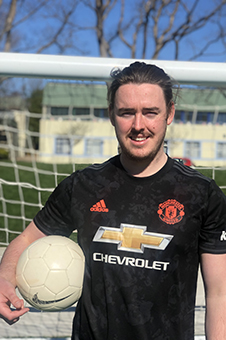Thursday 2 September 2021 10:52am
New Zealand should introduce guidelines to limit youth heading in football similar to those introduced internationally, a University of Otago researcher suggests.

Lead researcher Alex Gilbert
Lead researcher Alex Gilbert, a graduate of the Centre for Science Communication, says evidence of minor alterations to brain structure and function linked to heading exposure prompted the United Kingdom and United States to introduce heading regulations for junior players.
“Sporting organisations have a duty of care to their players and with the remainder of Europe set to follow the restrictions imposed by other countries,” Mr Gilbert says. “Decision makers in New Zealand will soon be tasked with addressing this issue.”
In a paper recently published in Science and Medicine in Football, Mr Gilbert says even though there’s currently a lack of injury surveillance data to establish a definitive link between heading exposure and neurological deficit in youth players, it would be prudent for New Zealand to apply similar guidelines to limit heading exposure.
Damaging effects of sport-related concussion has received growing attention in recent decades, and damage caused by heading impacts in football that doesn’t result in concussion on clinical grounds is now attracting interest.
“Although heading a ball tends to result in relatively small impacts, it’s the sheer number of these impacts incurred over a long period of time during training and gameplay which may have a cumulative effect,” Mr Gilbert says.
“Even though there is currently a lack of injury surveillance data for youth players, what we can say is that young athletes, particularly adolescents, tend to experience concussion symptoms for a longer period of time than adults.
“This observation falls in line with an enduring concern that the brain may be more vulnerable to injury while in a highly developmental stage, hence the importance of limiting heading for young players.”
The United Kingdom and United States have taken slightly different approaches to their regulations. United States guidelines currently ban all heading for players aged 10 and under, with heading during training limited to a maximum of 20 per week for those aged 11 to 13.
The United Kingdom initially advised that players aged 10 and under abstain from heading, while those aged 11 to 19 have limited exposure in training. In July of this year the guidelines were updated to include all levels of the amateur and professional game.
The question of how to implement and enforce any future regulation in New Zealand poses certain challenges, and Mr Gilbert says any attempt to introduce heading restrictions will require a considerable amount of community engagement.
“Adherence to any guidelines requires an understanding and appreciation of heading as a potential risk, especially for vulnerable populations. In that sense, it’s essential that players, coaches, parents, and patrons of the sport, understand the rationale for adopting any restrictions.”
He adds it’s important that such regulation is viewed as a short-term intervention and that implementing guidelines similar to those introduced in the United Kingdom and United States can be easily reversed if future research sees fit.
“Any attempt to limit heading must be followed by efforts to assess the effectiveness of those regulations.”
For further information, please contact:
Alex Gilbert
Centre for Science Communication
University of Otago
Email alexwilliamgilbert@gmail.com
Guy Frederick
Communications Adviser Sciences
University of Otago
Mob +64 21 279 7688
Email guy.frederick@otago.ac.nz
